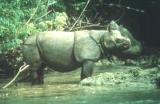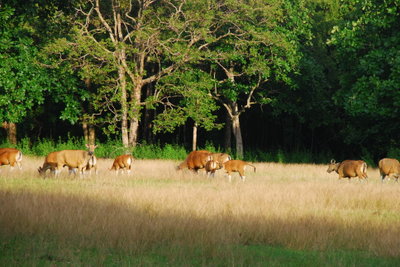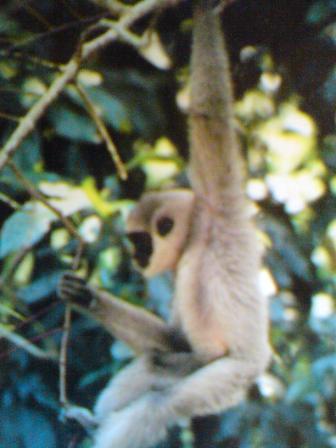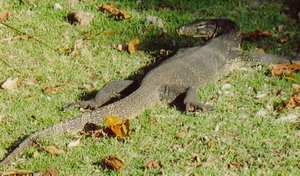|
Ujung Kulo Wildlife
Ujung Kulon has a vast array of
wildlife, quite a number of which are endangered or rare. Some of the animals
are so unafraid that they freely wonder in and around the tourist lodges,
others are sighted almost every day, many are heard rather than seen, and some
are rarely seen.
ANIMALS
Javan Rhinoceros (Rhinoceros
Sondaicus)
Rhinoceros Sondaicus
The most precious of all the
animals in the parks is the  Java one-horned rhinoceros, the rarest large animal
on earth. Once found across much of south east Asia, the first accounts of the
Java rhino date back to China’s
T’ang dynasty (A.D. 618-906) when Java was noted as a source for rhino horns.
In Java during the 1700’s rhinos were so numerous and damaging to the
agricultural plantations that the government paid a bounty for every rhino
killed, bagging five hundred within two years. Java one-horned rhinoceros, the rarest large animal
on earth. Once found across much of south east Asia, the first accounts of the
Java rhino date back to China’s
T’ang dynasty (A.D. 618-906) when Java was noted as a source for rhino horns.
In Java during the 1700’s rhinos were so numerous and damaging to the
agricultural plantations that the government paid a bounty for every rhino
killed, bagging five hundred within two years.
Ujung Kulon’s rhino population is
now estimated at around fifty individuals and they were believed to be the last
remaining Javan rhino in the world until a small population was recently
discovered in Vietnam.
However, these are so few in numbers that their viability is unlikely and so
Ujung Kulon remains the last home of this magnificent pachyderm. In appearance
the Javan rhino is closest to the Indian rhino, both having a single-horn and
skin folds or plates but there are distinct differences between their neck
plates and skin textures.
The Javan rhino also has a long
prehensile upper lip which extends below the lower allowing it to grasp
foliage. The body shape of the Javan rhino is designed to push aside the
undergrowth and only the male Javan rhino has a prominent horn while the female
has a lump similar to a halved coconut. Earlier this century Javan rhinos were
measures as being over 170 cm. At the shoulders, more than 3 metres in length
and 2,200 kg. In body weight but a recent photographic survey indicates that
the largest rhino in Ujung Kulon may be around 150 cm. in height. Rhinos range
over a maximum distance of 15 to 20 kilometres a day in the densely forested
lowlands of the Ujung Kulon Peninsula and to the east of its isthmus.
They are most mobile at nights,
like wallowing in mud pools and sometimes venture onto beaches and grazing
grounds. Although actual sightings of rhinos are rare, their prrints and droppings
are often found on the trails, sometimes unnervingly fresh. Javan rhinos are
believed to be capable of running as fast as a person and so advice to
visitors, should they happen to come across one, is to climb the nearest tree
and take a photo - in that order.
Deer
Far more obvious animals in the
park are the Javan rusaa deer that freely graze arround the tourist lodges.
These are the largest of the three deer species in Ujung Kulon. The rusa stags
are at their most magnificent in the mating season around August to September when
the antlers have shed their velvet and territorial battles between the stags
begin.
The smaller Barking deer has a
long sleek head and measures around 60-70 cm. at the shoulders. The stags have
short, two-pointed antlers and tusk-like canine teeth. Their favorite habitat
is low to the ground and when fleeing their white under-tail catches the eye.
The smallest is the Mouse deer which measures only 20-25 cm. in height and has
a reddish-brown coat with white underpants. The stag does not have antlers but
instead has long curving canine teeth that extend outside the mouth. In the
early years visitors to Ujung Kulon witnessed a Mouse deer ripping open the
stomach of a rival during a mating fight. Their habitat is within the forest
and they rarely venture onto beaches and clearings.
Banteng
Since pre-historic times these
wild cattle have lived throughout  Java and in the 17th century were used to
carry loads but now the herds roam wild and are found in just a few locations
throughout the island. The males have black coats while the females are usually
a golden brown and both have white buttocks and stockings. A mature bull can
measure over 170 cm. at the shoulders and although both sexes have horns, only
the males are large and curved. Banteng favor open grassy clearings for grazing
particularly early and late in the day but also feed on the forest’s young
secondary growth and are found throughout the Peninsula and southern Gunung Honje regions. Java and in the 17th century were used to
carry loads but now the herds roam wild and are found in just a few locations
throughout the island. The males have black coats while the females are usually
a golden brown and both have white buttocks and stockings. A mature bull can
measure over 170 cm. at the shoulders and although both sexes have horns, only
the males are large and curved. Banteng favor open grassy clearings for grazing
particularly early and late in the day but also feed on the forest’s young
secondary growth and are found throughout the Peninsula and southern Gunung Honje regions.
PRIMATES
Ujung  Kulon has five species of primates with
the brown, long-tailed, Crab-eating, macaques being the most commonly seen
especially on beaches and reefs at low tide. Peucang Island ssupports four separate groups numbering over two hundred individuals. Kulon has five species of primates with
the brown, long-tailed, Crab-eating, macaques being the most commonly seen
especially on beaches and reefs at low tide. Peucang Island ssupports four separate groups numbering over two hundred individuals.
The macaques’ strongly
hierarchical society is based on a marline system - daughters stay with the
mother as long as they live while juvenile males usually leave the group to
join another group or become solitary. Within the group structure there can be
several adult males with one being the dominant but tolerant leader.
Female macaques usually rank just
below their mothers and, interestingly, above older sisters so that even babies
from highly ranked mothers can control adult males and females. Primarily fruit
eaters, the macaques’ diet includes a wide variety of food and their cheek
pouches can hold the equivalent of a stomach load of food which allows for
hasty food gathering to be eaten later. Each group has its own territory and
although they sleep in trees they do not build nests and unlike the park’s
other primates they are equally at home on the ground or in trees.
Another primate, only found in
Java, is the glossy  blackish-brown Javan silvered leaf monkey which has long,
slender limbs and tail. They frequent most regions of the park particularly the
Gunung Honje Range but unlike the macaques their groups are small and usually contain one adult
male, several females and their young. The rarely seen Grizzled leaf monkey in
slightly heavier than the Javan silvered leaf monkey and has a grey coat, long
tail and head crest. Very small populations of this extremely rare and
endangered monkey live in the Gunung Payung and Honje Ranges. blackish-brown Javan silvered leaf monkey which has long,
slender limbs and tail. They frequent most regions of the park particularly the
Gunung Honje Range but unlike the macaques their groups are small and usually contain one adult
male, several females and their young. The rarely seen Grizzled leaf monkey in
slightly heavier than the Javan silvered leaf monkey and has a grey coat, long
tail and head crest. Very small populations of this extremely rare and
endangered monkey live in the Gunung Payung and Honje Ranges.
Also endangered is the Javan or
Moloch gibbon which is unique to West Java and its habitat in Ujung Kulon is
the primary forests of the Gunung Honje Range.
These tail-less primates have grey fluffy coats and black faces annd make a
distinctive hooting call resembling their Indonesian name Owa. Gibbons are
monogamous, mate for life and live in small family groups consisting of a male,
female and one or more young.
The young adults leave the group
to roam the forest searching for a mate and new territory. The parks’ fifth
primate is the Slow Loris and being nocturnal, sightings are uncommon. Around
25 to 30 cm. in size, it has an ash-grey coat and large round eyes for night
vision. The notable characteristic is its slow, smooth, perfectly co-ordinate
movements which allow it to freeze in mid-movement for self protection if
disturbed.
Wild Pigs
Ujung Kulon has two types of wild
pig, the Eurasian wild pig and the Javan warty pig. Similar in size and weight,
the Eurasian wild pig sometimes has a light grayish-white stripe from the head
to the chest while the male Javan warty pig has three pairs of lumps or warts
on the face which can give an old male a monstrous appearance. The coat of the
young Eurasian piglet has long yellowish-brown stripes and when disturbed they
often make short loud grunts while warty pigs have a high pitched cry. Wild
pigs are surprisingly good swimmers and have been known to cross the 700 meters
channel between the Peninsula and Peucang island.
CATS
The cat family was represented by
five species although the last positive sighting of a Javan tiger in Ujung
Kulon was in the 1950’s and it is believed that they are now part of the long
list of the world’s extinct animals. However, leopards measuring over half a meter
at the shoulder and over 1.5 meters in length, number as many as sixty in Ujung
Kulon and their tracks are sometimes seen on beaches and stream beds.
The black rosette on their coat
have background colors that can vary from a light straw yellow to orange-yellow
and it is not uncommon for the leopards to have completely black coats. Fishing
cats, named for their ability to scoop fish out of water, are considerably
smaller than leopards but larger than domestic and the jungle or leopards cats,
which tend to frequent the boundary regions of the park near settlements.
CIVEST
Between a fox and ferret in size
with short legs, long muzzle and a tail the same length as its body, the most
often seen of these predators is the Common palm civet which is found
throughout the park including Panatian Island.
WILD DOG
These are quite different from
the domesticated village dogs seen throughout Indonesia as they are smaller,
squatter, have a red-brown coat and a fox like appearance. They live hunt in
packs and in 1846 there was an account of hundreds of large turtles, some of
which were well over a meter in length, being over-turned and killed by a dog
pack on Ujung Kulon’s south coast. Then unaccountably their numbers decreased
to the point where they were never seen in Ujung Kulon until earlier this
century when they again re-appeared, possibly partly due to the dwindling tiger
population.
BIRDS
Although over 250 species have been recorded
in Ujung Kulon, the birds are not always easily seen as many live high in the
forest canopy or are vigilant inhabitants of the dense undergrowth. However it
is the constant bird calls of Ujung Kulon that contribute to the atnosphere of
the forest, for seldom is the park silent.
AMPHIBIAN AND REPTILS
* Crocodiles
* Turtles
* Frogs
* Lizards
* Snakes
INSECTS
The world's vast numbers of
invertebrate species, which out-number the animals by ten to one, have
extremely important roles as pollinators, re-cyclers, pest controllers and
generally keep the forests alive and healthy.

|